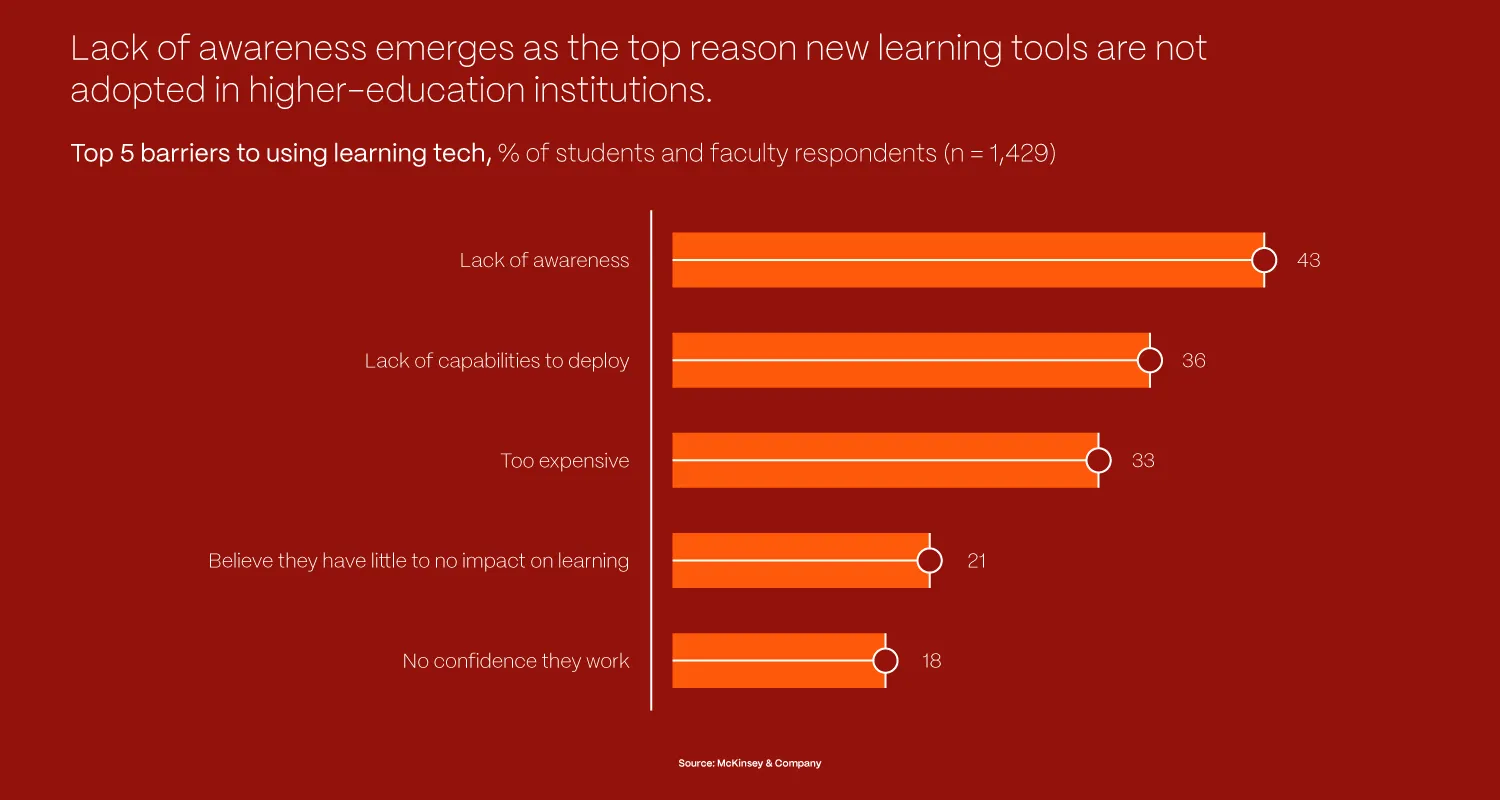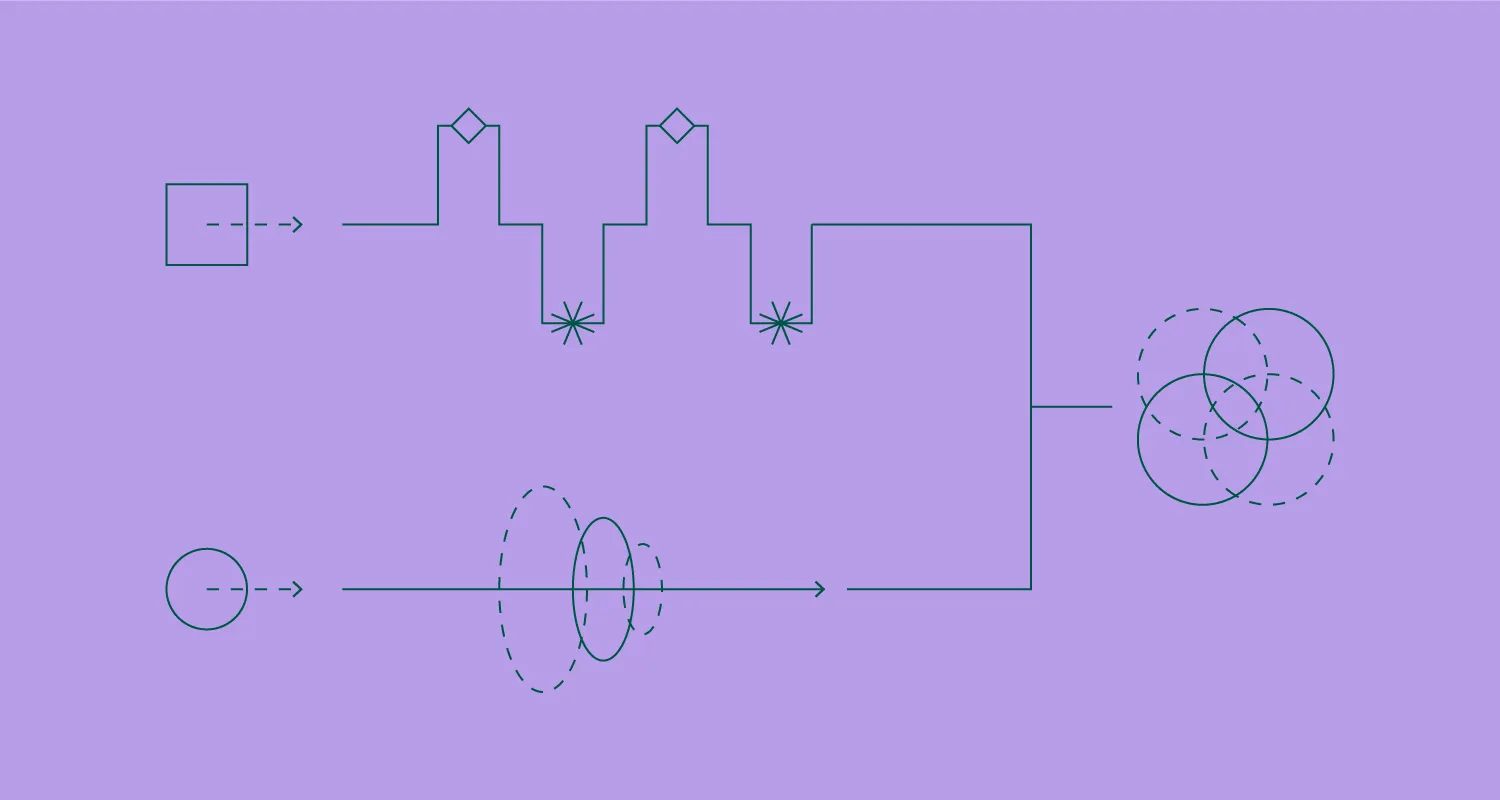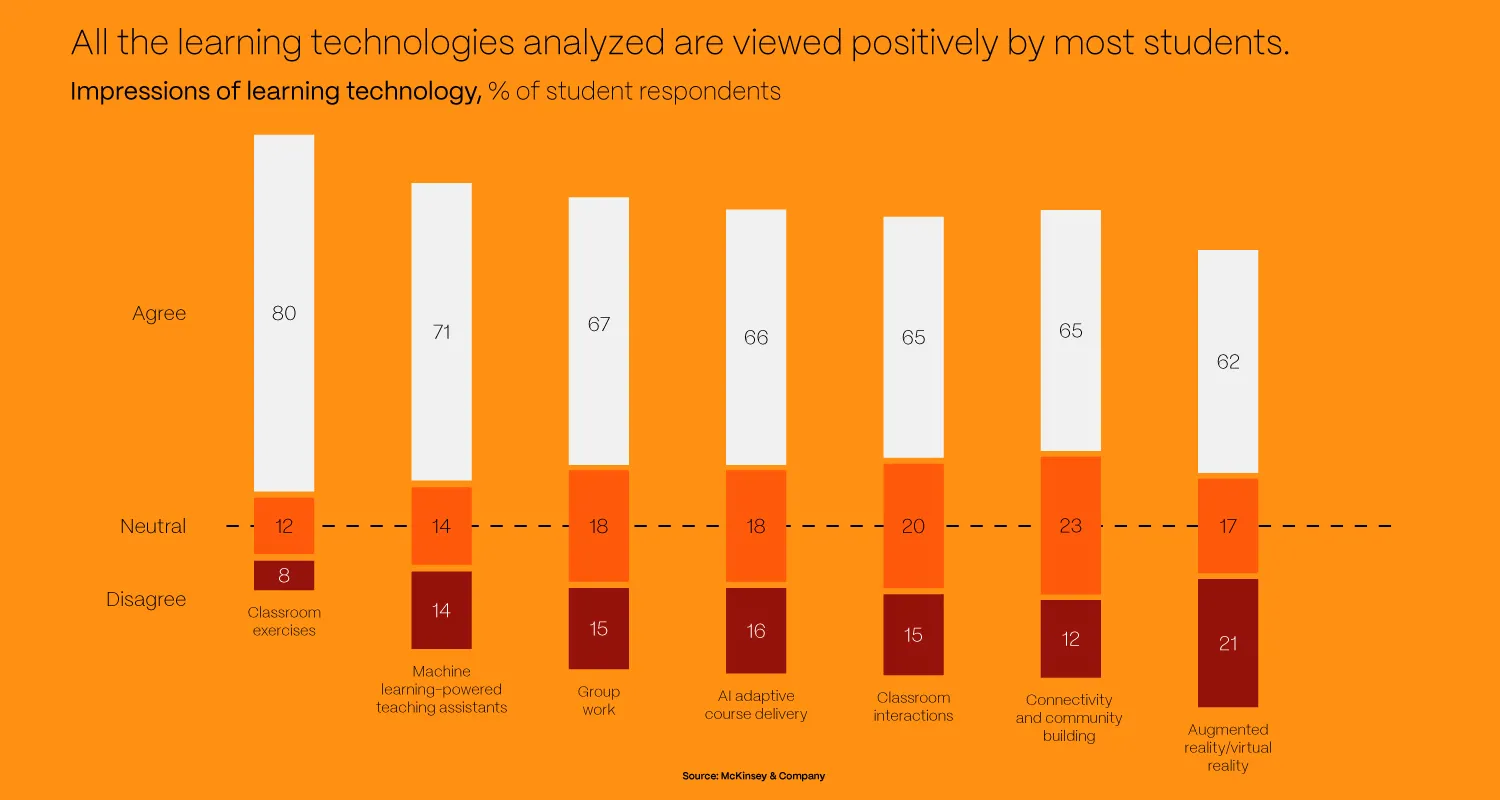Why AI in EdTech is the disruptor we need

Table of contents
In 2011, Stanford University offered three free online courses, attracting hundreds of thousands of participants. Two of the Stanford professors who taught these courses, Sebastian Thrun and Peter Norvig, went on to launch Udacity, one of the early MOOC (Massive Open Online Courses) platforms.
This was a bold, groundbreaking step forward in the context of democratizing knowledge and making it accessible to the masses. And MOOC platforms are just one example of EdTech. There are also learning management systems, various educational apps that gamify the learning experience (Duolingo, anyone?), and immersive technologies such as AR and VR that create virtual learning environments.
But if EdTech is so revolutionary in its mission to transform the way we teach and learn, why does it generally "lag behind" when it comes to technological advancements? Moreover, why does it shy away from AI?
Risk aversion puts EdTech in danger
When you consider what happens within any educational institution or organization, you can notice some universal patterns that block change. There are two main reasons why EdTech is not keeping up with new technologies:
Lack of awareness
According to McKinsey, lack of awareness is the number one reason new tech learning tools are not implemented in education.
Each educational institution or organization has to invest in its people. Continuous professional development of personnel, whether it’s teachers, professors, or educators – that’s what ensures good quality educational programs. Add creating annual plans and curriculums to the mix, and you’ll soon realize all of this takes up a lot of time and resources. Teachers are busy. They don’t have time to explore technologies and potential applications in their classrooms.
Lack of resources and capabilities to deploy
EdTech is well known for its careful selection of technology. Whatever gets chosen needs to strike a balance between longevity and practicality. In other words, the technology has to be impactful for a sufficient amount of time to justify learning it. It also has to be practical enough. Otherwise, it wouldn’t make much sense to implement it into the educational system.
New technologies require new hardware or specific environments, and that can be quite expensive. Schools and higher educational institutions have limited budgets that are planned well in advance, typically once or twice a year. In this context, new technologies are always seen as “nice to haves” and fall down on the priority lists.
Additionally, in the wrong hands, technology can be easily exploited or maliciously used, defying its purpose in the educational space. This makes it a bit clearer why educational organizations want to maintain the status quo and play it safe.
Times are changing, EdTech needs to keep up
It is inevitable that AI will be used in everyday life. In fact, it is already being used, even though stable generative AI (GenAI) has only recently emerged. Just think about all the ordinary people who are turning to ChatGPT, Bard, and Bing Chat to get immediate answers. There is virtually no learning curve to it, and this is why it’s spreading like wildfire.
Objectively speaking, AI-related skills will be sought in the future and we are yet to discover the full potential of generative technologies. For the first time ever, there are job ads for AI Prompt Engineers. Artificial intelligence is not only reducing the number of steps we need to take to perform an action, but it’s also fundamentally changing our economy. This will continue to happen – regardless of whether or not EdTech embraces it.
There is a scientific explanation that adds another layer as to why EdTech is not keeping up. It’s challenging to navigate yet unexplored waters, and the uncertainty can be rather stressful. According to a UCL study from 2016, uncertainty can cause more stress than inevitable pain. In other words, humans would rather be certain a bad thing will happen than uncertain of what will happen (be it good or bad). In a traditionally underbudgeted sector such as education, the unpredictability is just a lot to handle.
Be that as it may, we argue that AI can be safely integrated into EdTech. The opportunity is too good to miss out on. Precisely because so many shy away from it – gaining a competitive edge comes down to bravery to think two steps ahead.
Why EdTech needs AI
AI can give science power that humans alone could never achieve. It can be used as a consultant for various topics, assist with calculations in math, or, in a more general sense, be a tool for better problem-solving. It gives us momentum and removes roadblocks for us, allowing for a more efficient learning process.
It’s borderline dull to emphasize that AI won’t replace humans, but we have to say it, right? It’s an assistant or a thought-sparring partner. It’s not here to make us cognitively lazy but to help us allocate our resources to other fields we’ve been neglecting because we were so stuck in phase one of solving a certain problem.
Old-school educators have an inborn fear of technology as it is something that’s unknown and, therefore, implies unpleasant change. When calculators first emerged, how did the institutions react? Well, poorly. It was seen not as an advancement that would help humans learn faster but as a way to dumb students.
In 1981, the media was raving with controversial headlines such as “Teachers must fight computers,” feeding the apocalyptic projections that new technology would diminish literacy and create a generation of distracted young people with short attention spans. The truth is, if used properly, technology can help us reach new potential. It’s not about inserting a prompt into ChatGPT and letting it generate an essay for homework. It’s about leveraging the power of generative AI for research, critical analysis, practicing fact-checking, and facilitating fruitful discussions.
Digital native generations are naturally more inclined to adopt new technologies and be curious about their potential applications. This includes educational environments as well, which has been confirmed by McKinsey.
As one Japanese AI-first company stated–even if schools ban generative AI, students will still learn to use this technology because they won’t let schooling stand in the way of their education.
How higher education can use AI
AI has the power to revolutionize learning, research, and student experiences. From personalized learning paths to cutting-edge research advancements, it can offer a lot. But let’s look at it up close and see what its main applications are.
Increased engagement
One thing that AI brings to the table is the ability to adjust to every person's needs. This makes it easier for students to learn at their own pace and gives them proper guidance to where they want to go.
Let’s say you have a prospective student who’s involved in local green initiatives. By leveraging generative AI, higher education institutions can tailor their outreach efforts to each individual. Yes, this means that personalization at scale is possible. In this example, AI can create specific content that showcases environmental science programs available at the institution, campus recycling initiatives, student advocacy groups, and more.
This is proof that technology can make us more human and support relationship building. Imagine how the candidate must feel when they engage in personalized admission conversations or coaching. Generative AI tools can help address student questions immediately and are even trained to generate institution-specific responses. It’s possible to create custom GPT models, but with that–we’re barely scratching the surface.
Improved efficiency
Most of us are probably familiar with chatbots and how they work. But with AI integration, they could evolve even further. Instead of just providing answers to student questions, chatbots could alert the students about an upcoming deadline or guide them through any school activity. AI can learn from each interaction and previous user behavior to present information in the most compelling way. This aids learning, efficiency, and engagement.
Artificial intelligence is already significantly impacting advisor and administrator tools. Take predictive analytics, for example. Early-alert systems can help institutions identify “at-risk” students so that they can immediately react (with a personalized approach, of course).
Then there’s automation. Think about all the repetitive, rules-based tasks in areas such as case management and degree planning. AI can take care of that, allowing advisors to dedicate more time to meaningfully interact with students. In education, there is a direct correlation between effective advising and higher student retention rates, and AI is there to help with that.
Curriculum planning and personalized learning
In its current state, generative AI does one thing extremely well: it can synthesize vast amounts of information and provide assistance to educators in course development.
Picture a History professor preparing for the next semester. With just a simple prompt, they can task ChatGPT to come up with a comprehensive course outline. Not only that, but also to curate a list of relevant historical documents and artifacts, and generate detailed lesson plans based on the available historical data. Moreover, ChatGPT could assist the professor in discovering new research, articles, and multimedia content to refresh existing lecture materials.
It’s important to mention, though, that ChatGPT had data cutoff in January 2022. This means that if you ask it who the current monarch of the United Kingdom is, it will answer Queen Elizabeth, even though she passed away.
Looking beyond immediate applications in course planning, generative AI can also transform software applications or digital learning platforms by offering personalized content. It can dynamically adjust format, level, and pace based on student progress. Not only that, but it can also incorporate collaborative inputs from learner groups and create interactive experiences.
This caters to all types of learners. Imagine creating a podcast-style version of the class material for students with one click of a button. Pretty amazing, isn’t it?
Encouraging students to use GenAI
Generative AI is still in its infancy, but it’s already making an impact across all industries and sectors, EdTech included. Large Language Models (LLMs) are here to stay, and ignoring that fact can only harm students’ readiness for real life after they finish their education.
An increasing number of careers will have high exposure to GenAI, and forward-thinking institutions need to equip future workers with a set of skills to thrive in this new market. Teaching students how to use generative AI can be implemented in many different ways. Teachers should encourage interactions with AI to boost students' confidence in using this technology on a daily basis.
For example, what if instead of asking students to write an essay on a given subject, the professor would encourage them to write it with the help of AI? The point of the assignment wouldn’t be in the essay itself but in the process of collaborating with the generative AI tool. This could help them strengthen their prompting skills, think critically, and discuss why the tool generated the response it did.
The future is already here, but EdTech risks staying in the past. In fact, OpenAI is currently developing the OpenAI Academy. This project will use GPT-5 to provide accessible and high-quality education. Who’s it for, you might ask? It’s for anyone who wants to learn anything.
With all those ways AI could save professors time they usually waste on repetitive tasks, students would have more room to talk to their mentors on relevant matters where AI still falls short. Exchanging real-life lessons and building stronger bonds will become easier.
Other ways professors can leverage generative AI in their classroom include:
- Role-playing challenging conversations and using ChatGPT as a debate partner that points out weaknesses in student argumentation
- Building quizzes and tests that you can refine and adjust to the students’ learning levels
- Strengthening the fact-checking skills of students by encouraging them to engage in a conversation with GPT models and build critical thinking skills
Don’t fall behind
Generative AI is an opportunity, not a threat. Like all new technologies, it is marked by the unknown for those who have yet to adopt it. But with adoption comes adaptation as well. There is greater value in overcoming the fear of novelty than there is in the safety of staying put. If used well, GenAI can vastly improve the entire EdTech industry and make sure everyone’s learning needs are met. It protects diversity and helps humans reach their true potential.
However, if the educational system fails to implement GenAI, It can bring more harm than good. We’re not turning a blind eye to that. GenAI can make the differences between groups of students more prominent and increase the knowledge gap because some groups are more adaptive and accustomed to new ways of learning. Students could also feed GPTs with bad data and misuse the chatbot to make it give improper suggestions. That’s the reality of modern mischief.
Balancing between pros and cons can be difficult, but the tradeoff is clear when you have an expert by your side. At Vega IT, we have AI expertise as well as extensive experience working with both EdTech companies and institutions that use their tech solutions. Want to discuss your challenges and see how we can help? Contact Vega IT today.
Real People. Real Pros.
Send us your contact details and a brief outline of what you might need, and we’ll be in touch within 12 hours.










